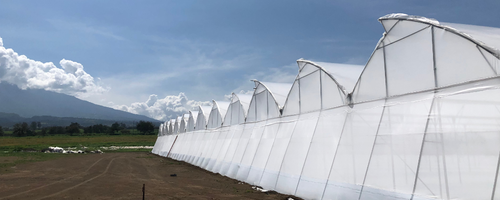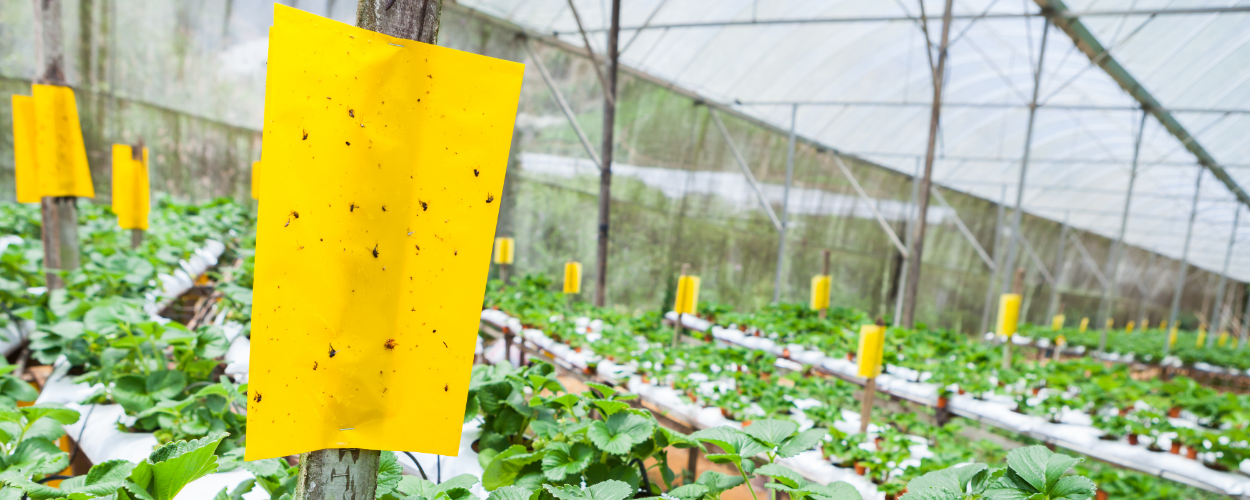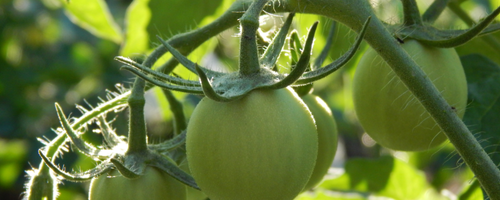
Excluding thrips from peppers in hot weather: A case study one year on

It’s been a little more than a year now since we did our work with Gomalor in Tuxpan, Jalisco, Mexico.
The results of the trial – which were striking for all of us – and the shoulder-to-shoulder work with Samuel and José made it a great project. Just the way we like it. Nice collaboration and a strong result.
Samuel del Toro is the owner and General Manager at Agricola Gomalor with extensive experience. José Morán is the head grower and he was involved in building the houses and manages the crops very carefully.
Combatting thrips in this kind of environment is a challenge. By the time a customer comes to you they have already tried dealing with an infestation. Now they’re focused on excluding the problem, which is understandable.
And yet, generally at this point you want to take a step back. There’s other things that have to considered. With Gomalor, they were aware that they needed to maintain a well-ventilated greenhouse environment. And so this was part of our thinking from the outset.
No wind. Open fields. And hot.
I remember coming on site when we were installing the nets for the trial. You could tell that there were potential challenges. The greenhouses are rather low so the high temperatures in the greenhouse stay near the plants.
.jpeg?width=1200&length=1200&name=inside%20green%20house%20almost%20finished%20(1).jpeg)
.jpg?width=1200&length=1200&name=inside%20the%20green%20house%20(this%20mini%20bell%20pepper%20variety%20is%20a%20small%20plant).jpg)
.jpg?width=1200&length=1200&name=Region%20of%20th%20project%20and%20greenhouse%20building%20in%20process%20(1).jpg)

In Tuxpan, it’s not that it’s always a super hot, but at midday like in many parts of Mexico, the sun can be so hot.
When you are aiming for a winter crop, you start your growing in the months of July and August. So right at the start of the cycle you can have these extreme temperatures to deal with at midday.
They were building new greenhouses and they knew they wanted to keep thrips out of these new buildings. We chose Xsect X-air for all the windows and we chose Xsect Xtra for the sidewalls which were close to nearby berry crops. Historically, they had more problems with those side walls. They could easily say where the Xsect Xtra was needed.
Gomalor have really done a great job at Tuxpan, though, working up from a smaller greenhouse to just under 10 Ha now, with further plans underway.
I spoke to Ying, our Climate Consultant in Shanghai, and she has also worked with a customer with similar challenges.
There were surrounding corn fields that harbored thrips. Testing showed sector by sector that the gables against these fields were much more susceptible to infestation.
Using a trial as a way of learning before full implementation
Like Ying, when I work with a customer, I’m really happy if they want to take one or two greenhouses and test the solution before moving on.
José, who is Production Manager at Gomalor, has it about right when he says to focus at the outset.
He told us: “During the trials, strategically place the nets in the area where you have the highest incidence of thrips, either in the front or on the lateral, and observe the results.”
What we learned at Gomalor
After monitoring and controlling the environment, we observed a remarkable 50% reduction in thrips infiltration compared to previous years.
This heightened control directly translated to enhanced crop quality, with minimal pest-induced damage, resulting in 85-90% of the plants thriving through the cycle.
In Greenhouse #6, where Gomalor fully applied Svensson's solutions, there were substantial savings in pesticide applications.


It was shoulder to shoulder work with owner, Samuel del Toro, and head grower, José Morán
It’s always great to reduce applications if you can. It costs money, and the plant gets stressed and stops working correctly. The efficiency is reduced.
José reported a notable 30% decrease in applications during the trial year, indicating both efficacy and efficiency gains.
When hot gets hotter
This was such a satisfying project. Even during the trial, the production and quality increased.
As we hoped for, the bell peppers gave an additional week of production. Gomalor went on in the 2023-24 cycle to equip Greenhouse 7 with Svensson nets, with Xsect X-air installed on the zenith windows, the laterals, and one front side. On the other side Xsect Xtra was installed.
Today we’re working together with Samuel and José to look at their new greenhouse, where the company wants again to exclude thrips. But here, the feeling is that it’s even hotter. We’ll make a careful assessment, using what we’ve learned. I want to try some new solutions with the team.
What do you think?
By the way, what do you think of the look of the greenhouses? I think it feels very robust when we confect together the insect net with Solarwoven. José says it’s made his job easier: "Thanks to the decision to confect the net along with Solarwoven, the installation work was easier, which provides operational and structural advantages, as it is easier to handle once installed,” he told us after the first trial.
Leave me a comment. What’s been your experience with thrips exclusion? What about these warmer winters? And what do you think about using nets when it’s hot?
Related articles

7 pests to exclude with insect nets (and 1 pollinator to care for) – a greenhouse grower's guide
There are seven insects you will want to keep out of your greenhouse when you’re growing in hot and arid or hot and muggy parts of the world. Most of..

Temperature up, humidity up, whitefly up: A perfect time to test insect nets in Western Mexico
“It’s 50 degrees in the greenhouse.” We know hot weather in Mexico, but when we hear those words in a phone call from a customer it conjures up a..
